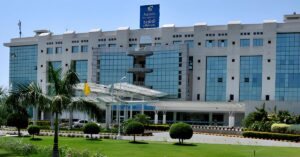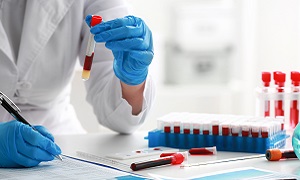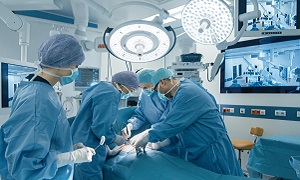Best Doctors in India for Pheochromocytoma Treatment
Best Hospitals in India for Pheochromocytoma Treatment
- City: Mumbai, India
Hospital Highlights:
- Fortis Hiranandani hospital was established in 2007.
- The hospital is an advanced tertiary care, multi-specialty hospital equipped with 149 beds.
- The hospital is equipped with a super ICU to provide emergency medical care to critically ill patients.
- The hospital is NABH accredited.
- The critical care facility in the hospital is augmented with the state-of-the-art facilities that facilitate speedier diagnosis and efficient monitoring.
- The hospital provides specialty medical services in cardiology, orthopedic science, pediatric science, neurology, diabetic care, urology, nephrology, ENT, obstetrics, gynecology, cosmetic surgery, bariatric surgery, neuro and spine care.
- City: Gurugram, India
Hospital Highlights:
- W Pratiksha Hospital, Gurugram, is one of the best hospitals in the NCR region. It is also a top hospital in India for IVF. Since its inception, the hospital has performed over 5500 successful IVFs. The hospital also specializes in gynecology.
- With over 20 years of experience in providing quality healthcare, the hospital is known as one of the most trusted and valued health providers in India.
- Equipped with world-class medical facilities and advanced technology, the hospital’s doctors and clinicians also have a track record of delivering excellent results. The hospital is also known for focusing on preventive well-being as much as on curative treatment.
- The hospital has earned the trust of its patients, by providing the best available treatments at affordable costs.
- City: Gurugram, India
Hospital Highlights:
- Paras hospital was established in 2006 and is the 250 bedded flagship hospital of Paras Healthcare.
- The is supported by a team of doctors of international and national repute.
- The hospital is NABH accredited and also the first hospital in the region to have a NABL accredited laboratory.
- The hospital provides specialty medical services in around 55 departments including Neurosciences, Joint Replacement, Mother & Child Care, Minimal Invasive Surgery, Gynecology and Obstetrics, Ophthalmology, Dermatology, Endocrinology, Rheumatology, Cosmetic and Plastic surgery.
- The hospital is equipped with state-of-the-art technologies.
- City: Kolkata, India
Hospital Highlights:
- Fortis Hospital, Anandapur, Kolkata is a world-class super-speciality equipped with the latest technologies in the medical world.
- The hospital is NABH accredited.
- This state-of-the-art facility specializes in cardiology and cardiac surgery, urology, nephrology, neurosciences, orthopaedics, digestive care, emergency care and critical care.
- The hospital, governed by integrated Building Management System (IBMS), has a pneumatic chute system, for quick vertical and horizontal transportation between floors, facilitating speedy transfer of patient specimens, documents, reports, and medicines to the concerned departments.
- The hospital also has a nephrology department with over 28 advanced dialysis units.
- City: Mumbai, India
Hospital Highlights:
- SL Raheja hospital is a 140-bed multi-specialty tertiary care hospital that is being managed by Fortis Healthcare Ltd.
- The hospital is a benchmark in healthcare and medical facilities in the neighborhood of Mahim & the western suburbs.
- L.Raheja Hospital, Mahim has one of the most effective ICU and Casualty care services.
- The hospital provides specialty medical services in Cardiology, Oncology, Neurology, Orthopedics, Mother & Child Care, and in Diabetes.
- City: Mumbai, India
Hospital Highlights:
- Wockhardt Hospitals were established in the year 1973, originally called First Hospitals and Heart Institute.
- Wockhardt Hospitals are super specialty health care networks in India, nurtured by Wockhardt Ltd, India’s 5th largest Pharmaceutical and Healthcare company.
- Wockhardt Hospitals is associated with Partners Harvard Medical International, an international arm of Harvard Medical School, USA.
- Wockhardt Heart Hospital performed India’s first endoscopic heart surgery.
- The hospital has a state-of-the-art infrastructure equipped with the latest technologies and modern equipment.
- It has special Centers of Excellence dedicated to the major specialties to provide hassle-free and high-quality clinical care.
- City: Gurugram, India
Hospital Highlights:
- The CK Birla Hospital in Gurugram is a NABH-accredited multi-specialty hospital.
- The hospital strives to increase the quality of healthcare by focusing on UK NHS nurse and midwife training requirements. Policies and practices derived from the National Institute for Health and Treatment Excellence (NICE) recommendations in the United Kingdom ensuring that a strong focus on safety, high-quality clinical care, and sanitation is maintained.
- The hospital’s cutting-edge technology and facilities allow for real-time communication and seamless collaboration among caregivers, ensuring accuracy and the best possible results. Those with foreign experience and accreditations make up part of the hospital’s team of clinicians.
- City: Ahmedabad
Hospital Highlights:
- As a member of the Apollo Hospitals Group, Apollo Hospitals International Limited, Ahmedabad is one of the most popular and sought-after medical facilities in Gujarat.
- Through its 6 Centres of Excellence and various affiliated branches, which cover all specialties and subspecialties, the hospital provides the most advanced clinical services.
- Since its inception in 2003, the hospital has been providing each patient with the most up-to-date medical equipment and state-of-the-art technology.
- With more than 150 successful organ transplants, including liver and renal transplants, the facility has been able to build a strong and extensive organ transplant program.
- In addition to performing 600 surgeries and caring for over 1800 patients on an IP basis, the hospital sees more than 18,000 patients on average in the outpatient department.
- With one of the biggest cardiology teams in the area, the hospital provides state-of-the-art regional care treatment in Cardiac Sciences.
- Additionally, the hospital offers a broad range of Neuro Interventional techniques to help stroke patients recover more quickly.
- City: Noida, India
Hospital Highlights:
- Jaypee Hospital is the flagship hospital of the Jaypee Group.
- This hospital has commissioned 525 beds in the first phase and has been planned and designed as a 1200 bedded multi-specialty facility.
- It holds the accreditation of the NABH and NABL.
- The hospital has state-of-the-art infrastructure equipped with the latest technologies and modern equipment like 64 Slice PET CT, Dual Head 6 Slice SPECT CT, Gamma Camera, and Da Vinci Robotic Surgery for comprehensive robotic surgical solutions.
- It has special Centers dedicated to the major specialties to provide hassle-free and high-quality clinical care.
- City: Mumbai, India
Hospital Highlights:
- Reliance Hospital is one of the best super-specialty care hospitals in Navi Mumbai.
- The main purpose of this hospital is to become a trustworthy place for the best health and hope for society. The hospital is well connected to the suburbs of Mumbai and Navi Mumbai.
- The hospital has various specialty departments, viz., Accident & Emergency, Anesthesiology, Dental Services, Dermatology, Diabetology, Dietetics Nutrition, Endocrinology, ENT, Gastroenterology, General Surgery, Gynaecology And Obstetrics, Hepato Pancreato Biliary Surgery, Infectious Disease, Internal Medicine, Interventional Radiology, Laboratory Medicine, Minimal Access Laparoscopic Surgery, Nephrology, Neurosciences, Opthalmology, Orthopaedics, Paediatrics, Pain Management Palliative Care, Physical Medicine Rehabilitation, Plastic And Reconstructive Surgery, Psychiatry, Pulmonary Medicine, Radiology, Rheumatology, Transplant, Urology Andrology, Vascular Surgery
Pheochromocytoma
Pheochromocytoma is a rare type of tumor that usually grows in the adrenal glands, above the kidneys. It is also known as an adrenal paraganglioma or a chromaffin cell tumor. It is generally common in adults between the ages of 30 to 50, though people of all ages might have it. Ten percent of all cases are known to occur among children.
Your adrenal glands produce hormones for controlling things like your metabolism and your blood pressure. A pheochromocytoma releases hormones as well, at much higher levels than normal. These extra hormones can lead to high blood pressure, and this might lead to damage to several of your organs, such as your brain, heart, lungs, and kidneys.
Though most pheochromocytoma tumors are benign, around 10 to 15 percent of them are generally cancerous, and they might spread to other parts of the body.
Symptoms
People having these tumors suffer from high blood pressure all the time. For others, it can go up and down.
Most people also have at least one or more of the following symptoms:
- Constipation
- Dizziness while standing
- Pale skin
- Fast or uneven heartbeat
- Severe headache
- Nausea
- Tremors
- Shortness of breath
- Unusual sweating
- Stomach, side, or back pain
- Vomiting
- Weakness
- Anxiety attacks
- Unintended weight loss
These symptoms can occur suddenly, like an attack, multiple times during a day. For some people, they might occur only a few times a month. As the tumor grows, the attacks can get stronger and might occur more often.
In some people, the attacks might be triggered by certain things such as:
- Pressure on the tumor
- Massage
- Certain medications
- Physical activity
- Childbirth
- Surgery
- Too much emotional stress
- Foods containing excessive amino acid tyramine, such as red wine, chocolate, or cheese
Causes & risk factors
Researchers are still unsure of what exactly is the cause of pheochromocytoma. This tumor develops in specialized cells, which are termed chromaffin cells, located in the center of an adrenal gland.
These cells release certain hormones, primarily adrenaline, and noradrenaline that helps to control several body functions, such as heart rate, blood pressure as well as blood sugar.
Adrenaline and noradrenaline trigger your body’s fight-or-flight response when a threat is perceived. The hormones can cause your blood pressure to increase as well as your heart to beat faster. They also prepare other body systems in order to help enable you to react quicker. A pheochromocytoma causes more of these hormones to be released even when you’re not in a threatening situation.
People having certain rare inherited disorders are at an increased risk of pheochromocytoma or paraganglioma. It is also likely that tumors associated with these disorders will be cancerous.
These genetic conditions include the following:
Multiple endocrine neoplasias, type 2 (MEN 2) – This disorder results in tumors in more than a single part of the body’s hormone-producing (endocrine) system. Other tumors which are associated with this condition may appear on the thyroid, tongue, parathyroid, lips, as well as the gastrointestinal tract.
Neurofibromatosis 1 (NF1) – This can result in multiple tumors in the skin, pigmented skin spots as well as tumors of the optic nerve.
Von Hippel-Lindau disease – This disorder can result in tumors at multiple sites, which can include the central nervous system, endocrine system, pancreas as well as kidneys.
Hereditary paraganglioma syndromes – These are inherited disorders which may result in paragangliomas or pheochromocytomas.
Diagnosis
Your doctor might require multiple tests for diagnosing this condition. These can include the following:
- PET imaging
- MRI
- Blood plasma test for catecholamine and metanephrine levels
- Laboratory tests in order to assess the hormone levels
- Urine metanephrines test for catecholamine and metanephrine levels
Treatment
Generally, the primary treatment for pheochromocytoma is surgery for removing the tumor. However, before you go for surgery, your doctor should likely recommend certain blood pressure medications. These are meant to block the actions of the high-adrenaline hormones and to lower the risk of developing extreme high blood pressure.
You will likely receive few drugs which can include alpha-blockers, for improving blood flow and decreasing blood pressure and beta-blockers, to make your heart beat slowly with less force.
It is also likely that your healthcare team will instruct you to consume a high-salt diet. These medications can cause a huge drop in your blood pressure; a high-salt diet will help you draw more fluid inside the blood vessels, and prevent you from having low blood pressure during and after the surgery.
Surgery
During the surgery, in most cases, the surgeon removes the entire adrenal gland with a pheochromocytoma using minimally invasive surgery. For this, your surgeon will need to create a few tiny openings through which he/she will insert wandlike devices equipped with video cameras and small tools.
The remaining healthy adrenal gland is able to carry out the functions normally performed by two. Blood pressure will likely return to normal within a short time.
If the other adrenal gland has been removed, then during the surgery, your doctor will remove only the tumor, and spare some of the healthy tissue.
If a tumor is cancerous, the tumor and other cancerous tissues are going to be removed. However, even if all of the cancerous tissues are not removed, surgery might limit the production of hormones. It also helps in providing some control over the blood pressure.
Cancerous pheochromocytoma treatments
Certains pheochromocytomas are also cancerous. And therefore, other treatments can be required for them, such as:
MIBG
This is a special kind of radiation therapy. It combines MIBG, a compound that attaches to the adrenal tumors, with a type of radioactive iodine. The goal of the treatment is to deliver radiation therapy to a specific site and eliminate the cancerous cells.
Chemotherapy
Chemotherapy involves using powerful drugs for killing fast-growing cancer cells.
Radiation therapy
This treatment might be used for symptomatic treatment of tumors that have spread to other parts of the body and causing pain.
Targeted cancer therapies
Peptide receptor radionuclide therapy (PRRT)
PRRT combines a drug that targets cancer cells with a small amount of a radioactive substance. It allows radiation to be delivered to the cancer cells directly.
People having pheochromocytoma which is not cancerous generally have a 5-year survival rate of 96 percent, while for people with a cancerous tumor, the survival rate is 44 percent.
For ensuring successful treatment, an early diagnosis is not always enough. It is best that you seek out a surgeon who is highly skilled and experienced.
Complications
High blood pressure caused by the tumors can cause damage to various organs, especially tissues of the cardiovascular system, brain, or even the kidneys. Some of the critical conditions include the following:
- Heart disease
- Kidney failure
- Problems with the nerves of the eye
- Stroke














